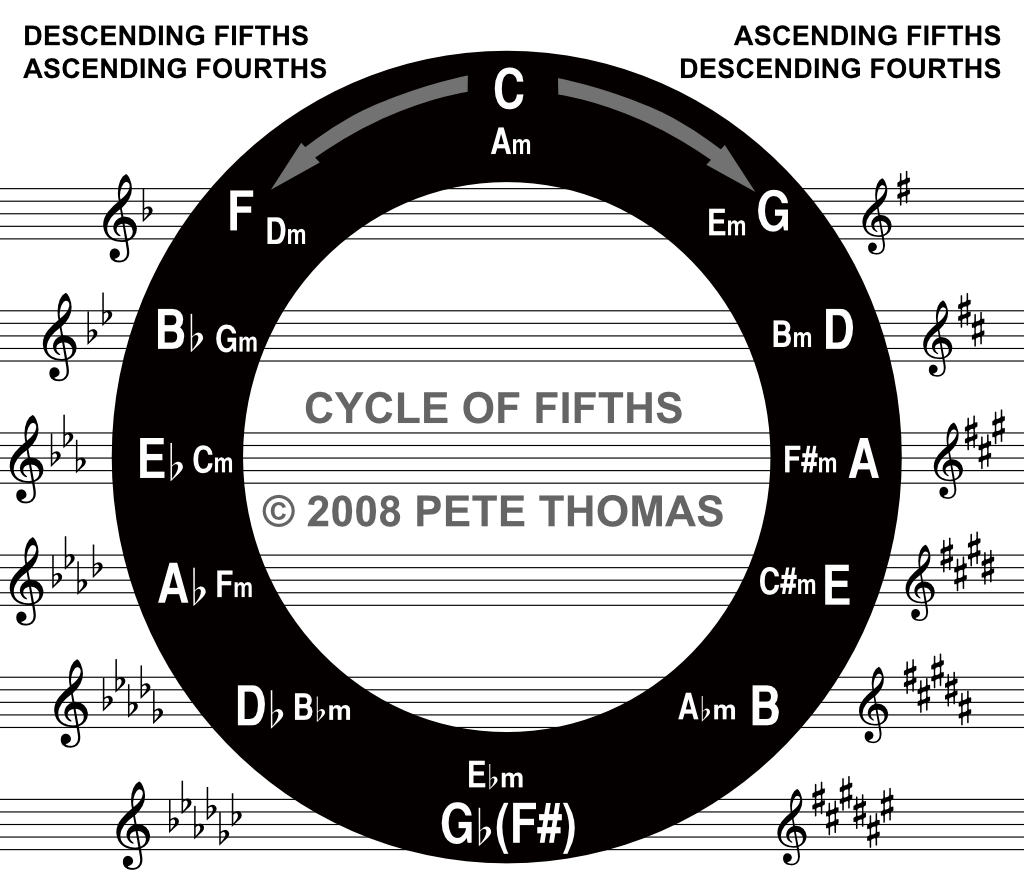In the previous tutorial I mentioned that diatonic root movement by a third is weak as the second chord has three out of four notes the same as the previous one. The strongest root movement is downwards by a perfect fifth (same as upwards by a fourth).
If we continue moving in fifths we have a progression which goes through all twelve notes available in western music and arrives back where it started. This is called the cycle of 5ths, or sometimes the cycle of 4ths. This is because if you progress round the cycle the other way (anticlockwise) the intervals are 4ths instead of 5ths.

Ex 3a: Cycle (or circle) of fifths – starting at C go anti-clockwise to see the tonic notes of the key and the number of sharps or flats in the key signature.
A IIm7-V7-I progression has a root movement that follows the cycle of fifths (D – G – C). By substituting chord I with chord III (which we cover next in ex 2e) we continue this cycle further (E – A – D – G – C). Carrying on this pattern an entire cycle can be made up of IIm7-V7s (ex 3b)
| Em7-A7 | Dm7-G7 | Cm7-F7 | Bbm7-Eb7 | Abm7-Db7 | F#m7-B7 | Em7-A7 |
| (key: D) | (key: C) | (key: Bb) | (key: Ab) | (key: Gb) | (key: E) | (key: D) |
ex 3b: Cycle of fifths (IIm7-V7-Is)
If each IIm7-V7 is given a key center, the progression contains 6 key centers each a whole tone lower than the previous one. There are therefore two different IIm7-V7 cycles, a semitone apart. (ex. 3b and c).
| Ebm7-Ab7 | C#m7-F#7 | Bm7-E7 | Am7-D7 | Gm7-C7 | Fm7-Bb7 | Ebm7-Ab7 |
| (key: Db) | (key: B) | (key: A) | (key: G) | (key: F) | (key: Eb) | (key: Db) |
ex 3c: Cycle of fifths (IIm7-V7-Is), using the 6 key centers not used in ex 3b.
If we continue the process of creating secondary dominants (see previous tutorial, ex 2f) we arrive at the cycle of fifths of dominant 7 chords (see above ex 3a). This sequence is very common in jazz. A very typical example is the bridge of Gershwin’s I Got Rhythm which we looked at here. There are countless jazz tunes based on the chord sequence of I Got Rhythm: Lester Leaps In, Anthropology, Cottontail and many more.
Note in ex 3d below the downward semitone resolution (voice leading) from 7th to 3rd and 3rd to 7th. Although the 3rd in a dominant 7th chord is a leading note and would normally resolve up a step, this chromatic descending line is often used as a feature of the cycle of fifths.

ex 3d: Analysis of a partial cycle.
The Difference – Cycle of Fourths or Fifths?
The only difference is really in the direction in which you travel around the circle. Look at the diagram and you will see that if you travel anti clockwise, the intervals are intervals of a fifth downwards. If you travel clockwise, the intervals are a fourth downwards.
A descending fifth is an important interval. When chords move from a dominant seven down a fifth to a tonic, this is a perfect cadence, a very strong movement which is often denotes the end of a phrase or the entire tune. As you may imagine, there is some confusion, as some people refer to the circle of 5ths as the circle of 4ths.
Here it is again:

Pretty Cool. Having been trying to understand iiv7 and the rest ….. Hearing of the fifths and fourths among us “music minus one” basement, etc
“practicers” ??? Today …. I finally see what I have been fooling with in books always trying to figure this out, among more theory stuff. I like this
stuff a lot. Just never got to be a musician except down here in the dungeon enjoying my instruments. Pete ….You’re a Big Man of skill in teaching.
Very Nice to come upon. Thanks for your site “Taming the Saxophone” And to think; all I was looking for was a fingering chart for friend who
wants to play alto.